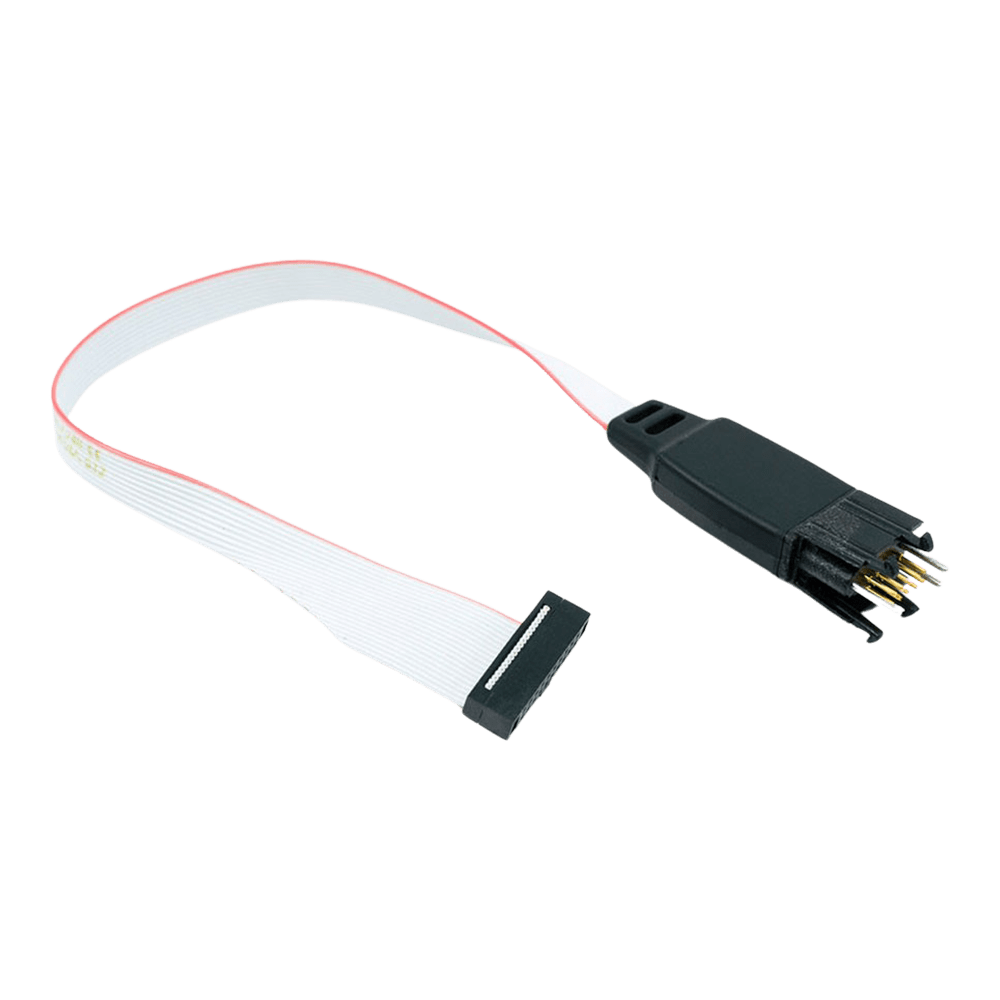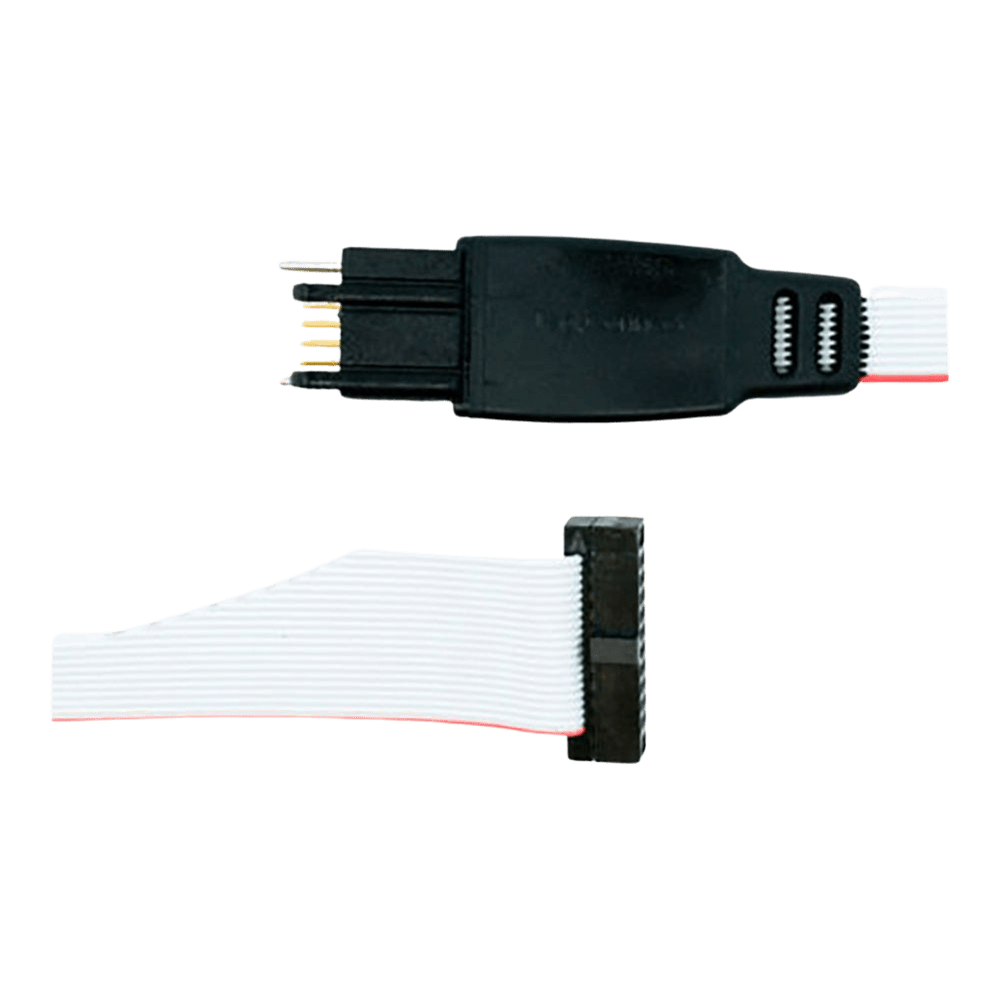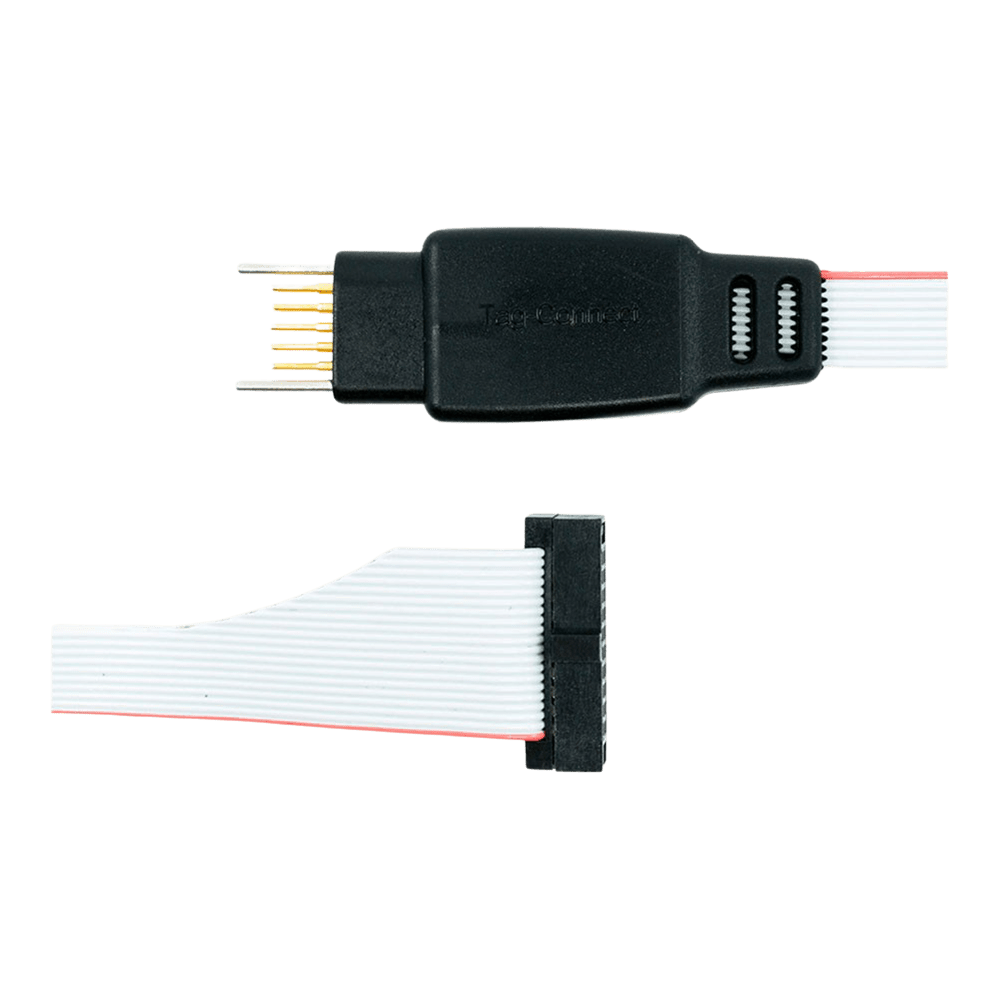


Key Features
Overview
The TC2070-IDC-050 represents Tag-Connect's development-focused approach to microcontroller programming and debugging. This legged variant incorporates four plastic retention clips that lock securely onto the PCB, enabling extended debugging sessions without manual cable support. The 0.05" pitch IDC termination ensures compatibility with modern debuggers including ST-LINK V3, ST-LINK V3MINI, and other STDC14-compatible tools.
Ideal for bench development where sustained connections are essential for setting breakpoints, single-stepping code, and interactive debugging. The retention system maintains reliable electrical contact during board movement or vibration. For production programming applications where brief connections suffice, consider the TC2070-IDC-NL-050 no-legs version which offers a smaller PCB footprint.
Compatible with MSP430, STM32, and other 14-pin JTAG/SWD applications. Retention legs provide mechanical stability for development environments whilst maintaining professional electrical specifications.
Downloads
Why Engineers Choose The Tag Connect TC2070-IDC-050 14-Pin Programming Cable
Hands-Free Development
Professional Reliability
Extended Session Capability
Development-Ready Programming Solution
The TC2070-IDC-050 combines professional microcontroller programming capabilities with hands-free debugging convenience through its integrated retention system. This legged version features four plastic clips that securely lock onto the PCB, enabling sustained development sessions without manual cable holding.
Key Connection Points
14-pin "Plug-of-Nails" spring-pin connector with plastic retention legs on the PCB end, whilst the debugger end terminates in a 0.05" pitch (1.27mm) female IDC connector for modern STDC14-compatible programmers.
PCB Footprint & Retention System
Requires gold-plated test pads, three alignment holes, plus four additional mounting holes for the plastic retention legs. The complete TC2070 footprint measures approximately 16.5mm x 11.1mm including leg clearance areas, providing secure attachment during extended debugging sessions.
| Parameter | Specification |
|---|---|
| PCB End | 14-pin spring contacts (with legs) |
| Debugger End | 0.05" pitch female IDC |
| Cable Length | Approximately 200mm (8") |
| Contact Rating | 100,000+ operations |
| Retention System | 4 plastic clips + 3 alignment pins |
Wiring Quick-Start
STDC14 Pin TC2070 Pin Signal -----------+-----------+-------- 3 1 VCC 4 2 SWDIO/TMS 5 3 GND 6 4 SWCLK/TCK 7 5 GND 8 6 SWO/TDO 9 7 KEY (NC) 10 8 TDI 11 9 GND Reset 12 10 Reset 13 11 N/C 14 12 N/C 1 13 N/C 2 14 N/C Development Advantage: Retention legs enable hands-free debugging, breakpoint setting, and code stepping without holding the cable manually.
| General Information | |
|---|---|
Part Number (SKU) |
TC2070-IDC-050
|
Manufacturer |
|
| Physical and Mechanical | |
Weight |
0.1 kg
|
| Other | |
EAN |
5055383665501
|
Frequently Asked Questions
Have a Question?
-
Is this cable suitable for automated test equipment integration?
The retention system makes it suitable for semi-automated testing where stable connections are needed, though automated test fixtures typically benefit from the faster cycling of the no-legs version with custom retention solutions.
-
How do I release the retention legs from the PCB?
Squeeze the two side tabs on the connector housing whilst gently lifting upward. The tabs compress the retention legs inward, allowing clean removal without PCB damage.
-
What signals are available beyond basic SWD debugging?
The full 14-pin interface provides JTAG/SWD debugging signals plus UART, power, and additional I/O pins depending on your debugger configuration. Consult your debugger's STDC14 pinout for complete signal mapping.
-
Can I remove the cable whilst power is applied to the target?
Yes, though it's good practice to pause debugging operations first. The retention system provides controlled disconnection that won't damage target circuitry when properly released using the side squeeze tabs.
-
Are the plastic retention legs replaceable if damaged?
The retention legs are integral to the connector housing and cannot be replaced individually. However, the robust design typically withstands hundreds of connect/disconnect cycles under normal development use.
-
How does the PCB footprint differ from the no-legs version?
The legged version requires four additional mounting holes for the retention clips, increasing the total footprint to approximately 16.5mm x 11.1mm compared to 16.5mm x 6.0mm for the no-legs variant.
-
What debuggers are compatible with the 0.05" pitch IDC connector?
Compatible with ST-LINK V3, ST-LINK V3MINI, and other debuggers featuring STDC14 (0.05" pitch) connectors. Also works with custom adapters for standard 0.1" pitch debuggers.
-
Can I use this cable for production programming applications?
While possible, the legged version is optimised for development. For production programming where brief connections are sufficient, the <a href="">TC2070-IDC-NL-050 no-legs version</a> offers faster connect/disconnect cycles and smaller PCB footprint.
-
How do I install the retention legs correctly on my PCB?
Position the connector over the footprint, align the three guide pins, then press down until all four plastic legs click into their mounting holes. Apply firm, even pressure across the connector body to ensure proper seating.
-
What advantages do the retention legs provide over the no-legs version?
The legs provide mechanical stability for sustained debugging sessions, eliminating the need to manually hold the cable whilst setting breakpoints, single-stepping code, or performing extended analysis. Essential for productive bench development work.
-
What is the difference between this part (TC2070-IDC-050) and TC2070-IDC?
Both have the same Tag-Connect “TC2070” legged plug at the PCB end — the difference is the ribbon/IDC connector pitch on the tool end.
TC2070-IDC-050 → 14-pin 0.05″ (1.27 mm) female IDC. This matches ST’s STDC14-style 14-pin headers used on probes like ST-LINK/V3.
Tag-Connect
TC2070-IDC → 14-pin 0.1″ (2.54 mm) female IDC. This suits debuggers that expose the classic 14-pin 0.1″ header (e.g., TI MSP-FET, PEmicro).
Tag-Connect
Both are “with legs” versions and plug onto the same TC2070 footprint on your PCB; pick the one that matches your debugger’s connector.



